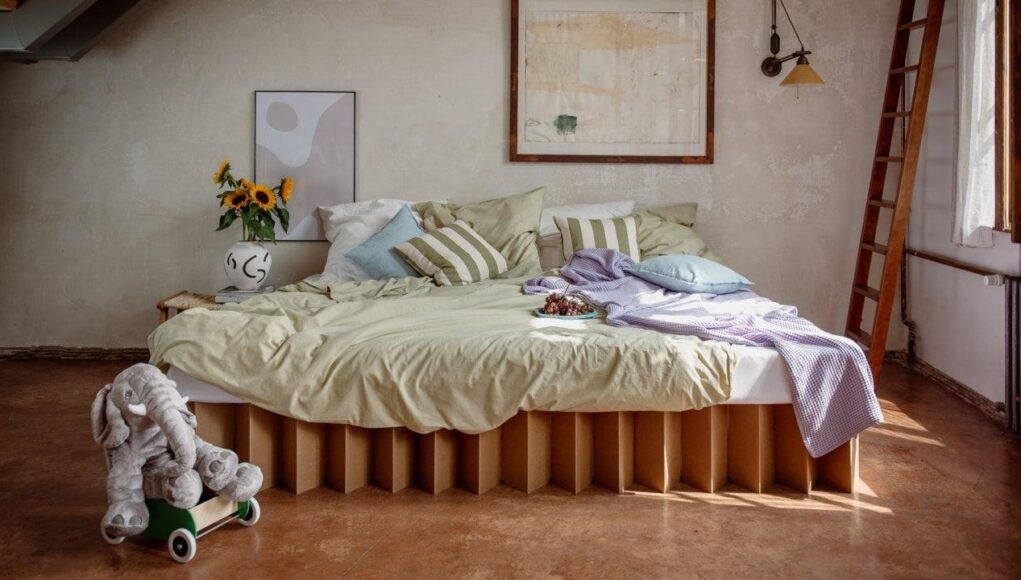Anyone who’s tried to purchase, spec, or fabricate furniture in the last two years is all too familiar with the global supply chain delays that are disrupting the design industry. A scarcity of basic building materials, along with staffing shortages at factories and backed-up international ports, has made it all but impossible to source or produce even the humblest of household furnishings.
A recent viral TikTok post put a spotlight on one possible solution: cardboard furniture. Frustrated by a 10–14 month waiting time for a traditional bed frame, Berlin-based user @kickiyangz shared an unboxing video and review of a cardboard bed from furniture start-up Room in a Box. Flat-packed, with pieces that easily slot together like a king-size wine carrier, the cardboard bed proved a sturdy, silent, and much more sustainable option than a throwaway frame from a low-cost retailer like Ikea.
Cardboard furniture has long been associated with the decor of desperation: disaster victims living in makeshift shelters, recently divorced dad pads, stingy students DIY-ing their dorm rooms. But is it time to take cardboard furniture seriously?
“There is a renewed level of interest and care that is helping to legitimize and modernize cardboard furniture and change some common conceptions,” notes sustainable design expert Sarah Barnard. “As an eco-friendly and surprisingly sturdy option, cardboard feels like an accessible material with a wide range of aesthetic possibilities.”
Indeed, furniture made from cardboard has been appearing in our lives and in the news more than ever. During the pandemic, cardboard desks, chairs, and laptop stands became temp-to-perm fixtures in people’s work-from-home spaces, sturdy enough for sustained use, but disposable for when (or if) we finally return to the office. At the Tokyo Olympics last summer, athletes’ cardboard beds sparked controversy over whether the ecological measure was actually intended to discourage…international relations, so to speak.
Today, it seems like a bunch of global designers are offering cardboard creations, from flat-packed shelving to DIY lamp kits, in options that range from open-source plans to pricey, one-of-a-kind editions.
Vancouver design studio Nordwerk has focused on cardboard’s material and structural potential since 2012. Their designs, which range from chairs to lighting and even large-scale environments, temper the cardboard construction’s rigid, rectilinear grid with sensuous parametric curves, pushing the aesthetic possibilities of the medium out of the, ahem, box.
Chic cardboard furnishings are certainly few and far between, but some of the more stylish options out there are those designed by Vadim Kirbardin, based in Prague. Kirbardin’s blacked-out chairs layer cardboard and paper into sculptural forms that channel classic lines by Thonet, Panton, and Rietveld. These one-off pieces and limited editions start at $4,000, but at that price (and with the amount of glue involved), they’re not likely to be recycled anytime soon.
Cardboard furniture may be trending, but it’s been around for at least half a century. The material (specifically the corrugated variety) dates back to the mid-1800s, when it was used to stiffen Victorian-era top hats. By the 20th century, intermodal shipping and the rise of retail chains made the cardboard carton ubiquitous. This strong, lightweight, and low-cost material called out to the pop designers of the 1960s, giving way to cardboard classics like Peter Murdoch’s cheap, cheerful (and disposable) Chair Thing kids’ furniture from 1964. In 1968, Frank Gehry began his experimentations with the industrial material that would turn into the Easy Edges series of laminated cardboard chairs, now icons of Postmodernism. In the 2000s, designs like Tokujin Yoshioka’s Honey-Pop chair, from 2000, or Nendo’s Cabbage Chair, from 2007, elevated paper-based furniture to a new level of elegance. Photorealistic cardboard furniture is now even used for staging houses—but don’t try to flop on the flimsy bed, it’s just for show.
One of the most obvious benefits of cardboard is its sustainability. When designed without glue or staples, your old cardboard chair can be readily recycled and turned into the next person’s armoire. Cardboard also requires fewer resources to manufacture than wood, metal, or plastics. It’s lightweight, available locally in most regions, and can be flat-packed—all factors that minimize its carbon footprint. The material lends itself to modularity, allowing bed frames, shelves, benches, and couches to be expanded or reconfigured without needing to be fully replaced. Plus, cardboard is more durable than you’d think. Keep it away from dampness (and cats), and your pieces can last for years.
For all its material merits, the biggest obstacle facing the wider adoption of cardboard furniture is that it tends to look like, well, cardboard. Painting or dyeing the surface conceals some of the rawness of the material, but can compromise its recyclability. For cardboard to stick around in a more permanent way, the challenge facing designers is how to make it both comfortable and suitable for different settings, while retaining its sustainability. “There are still endless possibilities that have not been explored,” says Maximilian Hansen of Nordwerk. “The rules for ‘what good looks like’ are not determined in the field of cardboard yet. There is so much room to be creative and progressive.”








